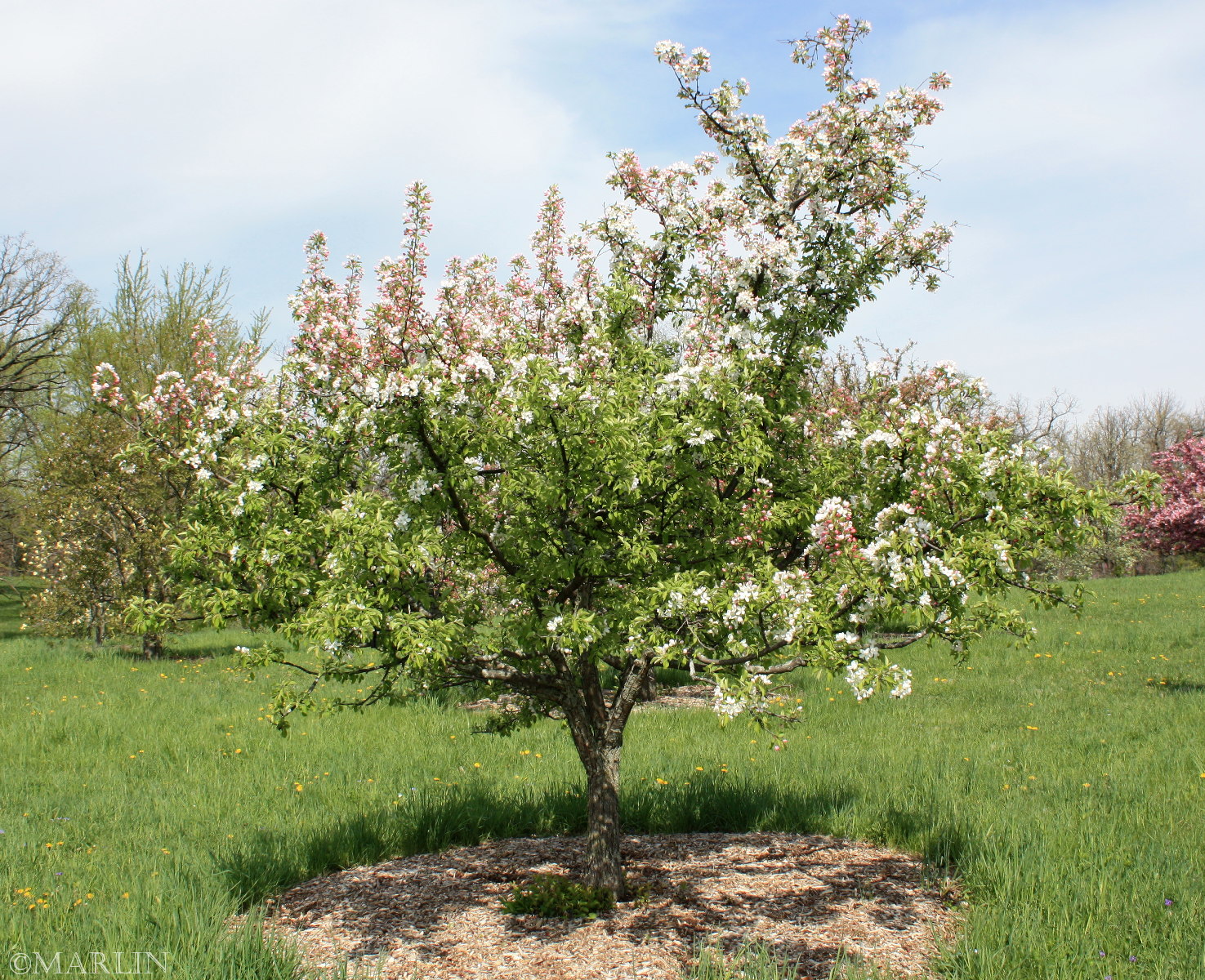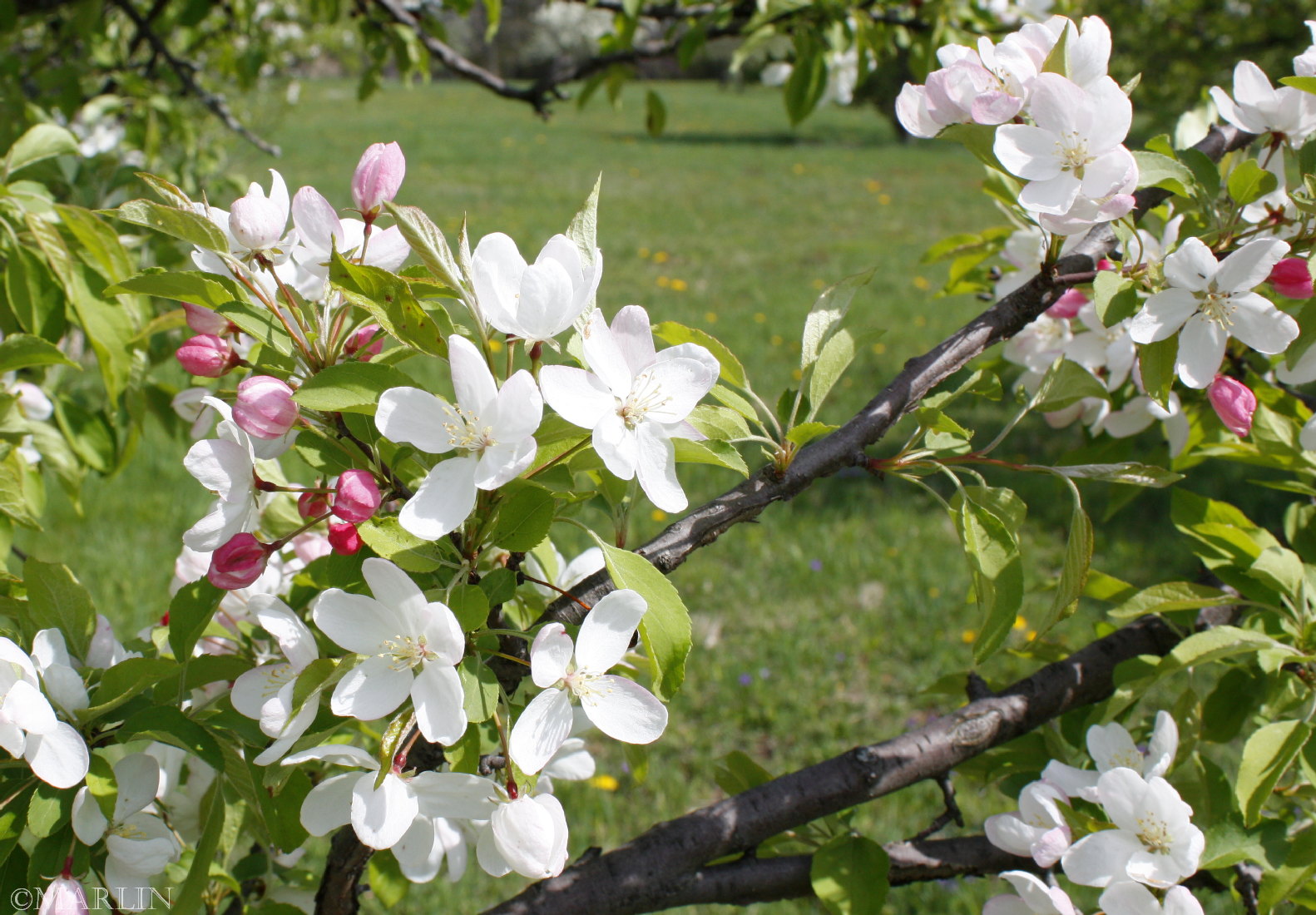Ormiston Roy Crabapple – Malus ‘Ormiston Roy’
 Malus ‘Ormiston Roy’- Ormiston Roy Crabapple, from a planting, is 25 years old
Malus ‘Ormiston Roy’- Ormiston Roy Crabapple, from a planting, is 25 years old
These pictures speak for themselves. This 25-year-old specimen at the Morton Arboretum red buds opening to white blossoms (sorry I missed the best this time) and dark green foliage. I think the stature of this specimen belies the “20-25 foot” mature height given by most websites. However, I cannot attest the growing conditions at this site meet the optimum. The Morton gives the following stats:
Height/Width: 20/25
Form: Up/Spreading
Bud/Flower: Red/White
Fruit: Orange Yellow
Disease Resistance: Scab-Good/slight, Fire-Fair/susceptible, Rust-Good/slight, Mildew-Good/slight [4].
Crabapples vary greatly in their shape and size. The mature size of the plant should be considered in your selection. The size of the landscape and the surrounding structures will dictate the plant size for a given space. There are several basic forms to consider: shrub (up to 15ft. tall) columnar (tall and narrow) horizontal ( layered branches, usually wider than tall) oval (taller than wide) upright (25-30 feet tall) rounded or spreading (usually somewhat wider than tall) weeping (little variation within the desirable cultivars, all grow to about 15ft.)
FRUIT
Trees only produce fruit after they have had flowers. The ornamental fruit of a crabapple puts on a show during the fall and winter. Fruits vary from less than ¼ to 2 in diameter. By definition, Malus trees with fruit larger than 2 inches are not crabapples, but apples. The best crabapple selections have small fruit, less than one-half inch, with bright, attractive colors (red, orange, and yellow). Some cultivars have showy fruits after hard frost, persisting (staying on the tree) throughout the winter, and providing food for birds. A few cultivars alternate every other year in flowering and bearing fruit, while some produce heavily one year and lighter the next. The non-persistent cultivars often produce fruit that can create an unwanted mess, especially when located near a driveway or sidewalk.
FLOWERS
Although flowers are usually the first consideration when choosing a crabapple, they should be one of the last. Flowering period is usually short, with bloom length dependent on the weather. Flowers may be single, double, or semi-double and colors vary from white, pink, or red. Flowers also have three distinct stages when blooming, from tight bud to balloon, and full bloom, often changing color with each stage [1].
References
1. Morton Arboretum, Crabapple: A Tree For All Seasons
2. Ormiston Roy Crabapple, Morton Arboretum acc. 98-84*1 photos © Bruce Marlin
3. Morton Arboretum, Crabapples for the Home Landscape
4. Morton Arboretum, ‘Ormiston Roy Crabapple’
Excerpts from Morton Arboretum articles used with permission
Family Rosaceae – Rose Family; Fruit Trees
Containing Hawthorns, Apples, Pears, Cherries, Plums, Peach, Almond, Mountain-Ash and Whitebeam. Rosaceae is a large family of plants with about 3,000 species in ~100 genera. Crabapple and other fruit trees provide some of our most outstanding flowering ornamentals, as well as food for birds and other wildlife.
Family Rosaceae – Rose Family; Fruit Trees
Trees Index | Pine Family | Beech, Oak | Nut Trees | Birch Family | Magnolias
Tree Encyclopedia / North American Insects & Spiders is dedicated to providing family-friendly educational
resources for our friends around the world through large images and macro photographs of flora and fauna.


